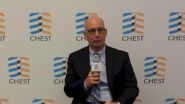(Press-News.org) As transistors get smaller, they also grow less reliable. Increasing their operating voltage can help, but that means a corresponding increase in power consumption.
With information technology consuming a steadily growing fraction of the world's energy supplies, some researchers and hardware manufacturers are exploring the possibility of simply letting chips botch the occasional computation. In many popular applications — video rendering, for instance — users probably wouldn't notice the difference, and it could significantly improve energy efficiency.
At this year's Object-Oriented Programming, Systems, Languages and Applications (OOPSLA) conference, researchers from MIT's Computer Science and Artificial Intelligence Laboratory presented a new system that lets programmers identify sections of their code that can tolerate a little error. The system then determines which program instructions to assign to unreliable hardware components, to maximize energy savings while still meeting the programmers' accuracy requirements.
The system, dubbed Chisel, also features a tool that helps programmers evaluate precisely how much error their programs can tolerate. If 1 percent of the pixels in an image are improperly rendered, will the user notice? How about 2 percent, or 5 percent? Chisel will simulate the execution of the image-rendering algorithm on unreliable hardware as many times as the programmer requests, with as many different error rates. That takes the guesswork out determining accuracy requirements.
The researchers tested their system on a handful of common image-processing and financial-analysis algorithms, using a range of unreliable-hardware models culled from the research literature. In simulations, the resulting power savings ranged from 9 to 19 percent.
Accumulating results
The new work builds on a paper presented at last year's OOSPLA, which described a programming language called Rely. Each paper won one of the conference's best-paper awards.
Rely provides the mechanism for specifying the accuracy requirements, and it features an operator — a period, or dot — that indicates that a particular instruction may be executed on unreliable hardware. In the work presented last year, programmers had to insert the dots by hand. Chisel does the insertion automatically — and guarantees that its assignment will maximize energy savings.
"One of the observations from all of our previous research was that usually, the computations we analyzed spent most of their time on one or several functions that were really computationally intensive," says Sasa Misailovic, a graduate student in electrical engineering and computer science and lead author on the new paper. "We call those computations 'kernels,' and we focused on them."
Misailovic is joined on the paper by his advisor, Martin Rinard, a professor in the Department of Electrical Engineering and Computer Science (EECS); by Sara Achour and Zichao Qi, who are also students in Rinard's group; and by Michael Carbin, who did his PhD with Rinard and will join the EECS faculty next year.
In practice, Misailovic says, programs generally have only a few kernels. In principle, Chisel could have been designed to find them automatically. But most developers who work on high-performance code will probably want to maintain a degree of control over what their programs are doing, Rinard says. And generally, they already use tools that make kernel identification easy.
Combinatorial explosion
A single kernel, however, may still consist of 100 or more instructions, any combination of which could be assigned to unreliable hardware. Manually canvassing all possible combinations and evaluating their effects on both computational accuracy and energy savings would still be a prohibitively time-consuming task.
But the researchers developed three separate mathematical expressions that describe accuracy of computation, reliability of instruction execution, and energy savings as functions of the individual instructions. These expressions constrain the search that the system has to perform to determine which instructions to assign to unreliable hardware. That simpler — though still complex — problem is one that off-the-shelf software can handle.
INFORMATION:
Written by Larry Hardesty, MIT News Office
Related links
How to program unreliable chips
http://newsoffice.mit.edu/2013/how-program-unreliable-chips
New mathematical framework formalizes oddball programming techniques
http://newsoffice.mit.edu/2012/loop-perforation-0522
Global warming is altering the reproduction of plants and animals, notably accelerating the date when reproduction and other life processes occur. A study by the University of Uppsala (Sweden), including the participation of Spanish researcher Germán Orizaola, has discovered that some amphibians are capable of making their offspring grow at a faster rate if they have been born later due to the climate.
Over recent decades many organisms, both plants and animals, have experienced a notable advance in the date when many of their life processes (like reproduction, migration ...
Soon, many will turn back the hands of time as part of the twice-annual ritual of daylight savings time. That means remembering to change the alarm clock next to the bed, which will mean an extra hour of sleep before getting up in the morning.
But for some diabetics who use insulin pumps, Saleh Aldasouqi, associate professor of medicine at Michigan State University, suggests that remembering to change the time on this device should be the priority.
"Some diabetes patients who use insulin pumps may forget to change the clock that is found in these devices," said diabetes ...
Rochelle, NY, October 30, 2014—Several companies are developing spacecraft designed to take ordinary citizens, not astronauts, on short trips into space. "Space tourism" and short periods of weightlessness appear to be safe for most individuals according to a series of articles on space biomedicine published in New Space, a peer-reviewed journal from Mary Ann Liebert, Inc., publishers. The articles are available free on the New Space website until November 30, 2014.
James Vanderploeg, MD, MPH and colleagues, University of Texas Medical Branch, Galveston, coauthored ...
Tropical Cyclone Nilofar was closing in on the border between Pakistan and northwestern India on Oct. 30 when NASA's Terra satellite passed overhead from space. Wind shear continued to affect the storm making it appear more like a comet with a tail, than a tropical cyclone.
The MODIS or Moderate Resolution Imaging Spectroradiometer instrument that flies aboard NASA's Terra satellite captured a visible image of Nilofar on Oct. 30 at 06:35 UTC (2:35 a.m. EDT). Nilofar was still being affected by southwesterly wind shear, which was blowing the clouds and showers to the northeast. ...
VIDEO:
Dr. Gerard Silvestri gives background on lung cancer screening recommendations.
Click here for more information.
October 30, 2014, Glenview, Illinois -- As the Centers for Medicare & Medicaid Services (CMS) Committee on Coverage studies the decision to cover lung cancer screening for eligible individuals, today's Online First section of the journal CHEST published Components for High Quality Lung Cancer Screening: American College of Chest Physicians and American Thoracic ...
Chicago, October 30, 2014 – The Society of Thoracic Surgeons (STS) has released new clinical practice guidelines for treating cancer of the esophagus and gastroesophageal junction (area where the esophagus meets the stomach).
The guidelines, published in the November 2014 issue of The Annals of Thoracic Surgery, include nine evidence-based recommendations that address issues related to multimodality care, including neoadjuvant therapy (chemotherapy and radiation therapy given prior to surgery). The goal of this therapy is to reduce the extent of cancer before an ...
Chicago, October 30, 2014—Analysis of 607 small cell lung cancer (SCLC) lung tumors and neuroendocrine tumors (NET) identified common molecular markers among both groups that could reveal new therapeutic targets for patients with similar types of lung cancer, according to research presented today at the 2014 Chicago Multidisciplinary Symposium in Thoracic Oncology. The Symposium is sponsored by the American Society of Clinical Oncology (ASCO), the American Society for Radiation Oncology (ASTRO), the International Association for the Study of Lung Cancer (IASLC) and ...
WASHINGTON – Young adults ages 18-26 should be viewed as a separate subpopulation in policy and research, because they are in a critical period of development when successes or failures could strongly affect the trajectories of their lives, says a new report from the Institute of Medicine and National Research Council. The committee that wrote the report found that young adults' brains and behaviors continue maturing into their 20s, and they face greater challenges achieving independence than their predecessors did, have lengthened pathways into adulthood, and are ...
The lemur, Javan rhino and Santa Cruz kangaroo rat are all lonesome animals. As endemic species, they live in habitats restricted to a particular area due to climate change, urban development or other occurrences.
Endemic species are often endangered, and a University of Tennessee, Knoxville, study finds that saving them is more important to biodiversity than previously thought.
Joe Bailey, associate professor in the Department of Ecology and Evolutionary Biology, and his colleagues from the University of Tasmania in Australia looked at endemic eucalyptus found in ...
Chicago, October 30, 2014—Patients who received post-operative radiation therapy (PORT), radiation therapy after surgery, lived an average of four months longer when compared to the patients who had the same disease site, tumor histology and treatment criteria and who did not receive PORT, according to research presented today at the 2014 Chicago Multidisciplinary Symposium in Thoracic Oncology. The Symposium is sponsored by the American Society of Clinical Oncology (ASCO), the American Society for Radiation Oncology (ASTRO), the International Association for the ...





